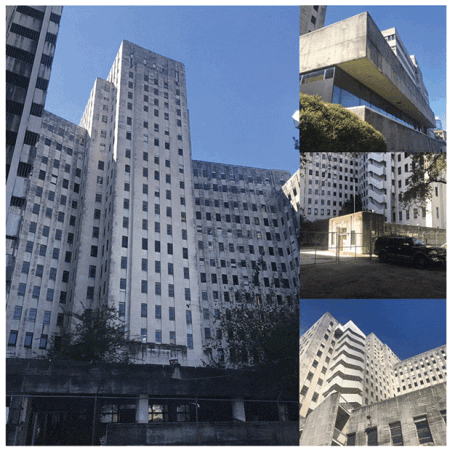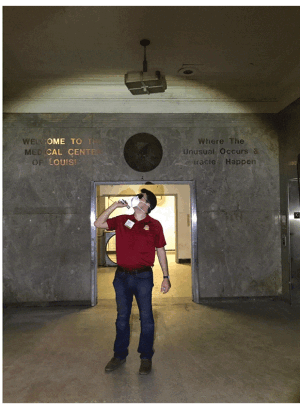Rising 20 stories above Tulane Avenue on the edge of downtown New Orleans, the historic Charity Hospital building has stood dormant for a dozen years since it was flooded by Hurricane Katrina.
For nearly 80 years, the 1 million-square-foot (93,000 sq m) art deco behemoth served as the primary health care provider for the city’s poor and became a beloved icon for residents across New Orleans. Today, Charity remains perhaps the most glaring indication of the city’s incomplete recovery from the historic 2005 storm.
In the years after Katrina, state officials opted to use federal recovery funds to build a high-tech $1.2 billion medical center half a mile (0.8 km) away from Charity, leaving the old hospital to languish. A lack of funding and political will has derailed multiple redevelopment efforts.
Now, a volunteer group of real estate experts is hoping to help jump-start the redevelopment process for the building and the surrounding district through ULI’s Advisory Services panel program.
The panel process connects diverse groups of real estate experts with communities to address challenging real estate and land use issues. The Louisiana State University (LSU) System, which owns the Charity building, commissioned a comprehensive land use study for the property through ULI’s Advisory Services panel process.
A group of ten real estate experts spent November 5–10 in New Orleans, studying the building and the surrounding neighborhood before interviewing dozens of stakeholders about their visions for Charity and the surrounding medical district. The panel presented its preliminary recommendations to the community in November and plans to release a more detailed redevelopment plan in early 2018 that local officials can build upon.
The initial report posited three multiuse, socially conscious, and financially sustainable scenarios for local officials to consider—all of which involve the preservation and redevelopment of Charity Hospital.
Panel member Liz Ogbu, owner of Studio O, a design and consulting practice in Oakland, California, said Charity Hospital represents a once-in-a-generation opportunity to catalyze the neighborhood and make New Orleans a leading example of how to foster inclusive and equitable revitalization.
“We believe that it is possible to build a new pathway for shared prosperity that truly can be part of the future of New Orleans,” she said. “That can only happen if there is a concerted effort to bring together stakeholders from across the spectrum to work together in new and innovative ways.”
History and Opportunity
Completed in 1939, “Big Charity,” as it is known to many locals, was the largest of Louisiana’s safety-net hospitals when Katrina struck in August 2005. Charity’s mission of caring for the poor and uninsured, however, stretches back to 1736, when it was founded by a French sailor and shipbuilder who left money in his will to finance a hospital for the city’s indigent. The hospital changed hands multiple times over the years, until the LSU System took it over in 1997 and operated it as a teaching hospital for medical students.
A year after Katrina’s floodwaters filled the building’s basement, it was clear that the state was moving away from the idea of reopening Charity Hospital at the same location. An interim hospital was established and the political wheels started turning for an alternative to Charity, despite opposition from some community members.
In 2015, the state opened the 2.3 million-square-foot (214,000 sq m) University Medical Center New Orleans, built with a $1.1 billion mix of federal, state, and private recovery dollars and run by a private operator contracted by the state. It includes a Veterans Affairs hospital and is part of an expanded medical district that encompasses parts of downtown and the nearby Mid-City neighborhood.
Despite repeated failed attempts to redevelop the Charity building, 2017 brought some momentum to the project when state officials approved a multimillion-dollar contract to begin cleaning out the inside of the abandoned structure. Another driving force behind the redevelopment has been Jimmy Maurin, founder of Stirling Properties and chairman of the LSU Real Estate & Facilities Foundation, which LSU created to help position some of the real estate it owns for better use.
Maurin said Larry Hollier, chancellor of the LSU Health Sciences Center New Orleans, approached the foundation in 2016 and expressed an interest in redeveloping Charity Hospital. Maurin, who has been a ULI member for three decades, suggested that the organization’s Advisory Services panel process could be an effective way to get an outside perspective on the property. LSU President F. King Alexander and the foundation’s leadership agreed in September to contract with ULI to commission the panel and the land use study.
“Quite frankly, I think they’re very excited about what they’ve seen already and what the possibilities might be for repurposing Charity Hospital,” Maurin said of the LSU leadership.
Panel of Experts
Chaired by John Walsh, chief executive officer of TIG Real Estate Services in Frisco, Texas, the Charity Hospital Advisory Services panel included a diverse set of voices with expertise across a range of sectors, including real estate, land use, design, and planning. “When I saw who the panel was, I said, ‘Wow, this is pretty special,’” Maurin said.
ULI’s all-volunteer panels aim to provide expert, independent, candid, and unbiased input to help jump-start critical conversations and move beyond decision-making dead ends. They work to help communities gain fresh insight and come to innovative solutions for complex land use and real estate development challenges.
The Charity panel kicked off its week in New Orleans with tours of the hospital and the surrounding medical district, and then interviewed about 80 stakeholders over the next several days to gather community input about the fate of the building and the surrounding neighborhood. The interviews were confidential, which gave the stakeholders the freedom to express their opinions candidly.
Spirit of Charity
In its initial suggestions for redevelopment, the panel outlined a set of guiding principles, starting with the notion of the “spirit of Charity”—the idea that both the physical building and the longstanding institution represent a key component of the city that should be preserved. It was an idea that came up repeatedly in the stakeholder interviews throughout the panel process.
“It’s iconic in nature. Its architecture is very unique and in many ways it’s a very historic building,” Maurin said. “There was nobody interested in tearing it down.”
Other guiding principles for the redevelopment include a clear and transparent process, an inclusive and equitable process and outcomes, financial feasibility, flexibility, high-quality design and construction, and strategic planning.
The initial report’s scenarios for redeveloping the building would cost in the range of $260 million to $285 million and cover a wide range of potential uses, including housing a newly consolidated city hall and city court in the building, along with multifamily residential units in the balance of the space. Other potential uses include workforce housing to meet the need in the medical district for affordable residential units, especially among health care workers, as well as various combinations of technology and health care facilities.
The plan also calls for the creation of a special tax increment finance (TIF) district called the Spirit of Charity Innovation and TIF District that would leverage some of the tax revenue generated in the area to develop it in a more comprehensive and inclusive manner than the recent University Medical Center project.
Several panel members said that despite the considerable investment into University Medical Center, it is clear that the new facility is not driving much development or activity beyond working hours. Panel member Carlton Brown, co–managing partner for New York–based Direct Invest Development, said that panel members walked the streets around the medical center just after 5 p.m. and found them largely vacant.
“There was no one on the street,” Brown said. “That is not a healthy district. That is a sign of a process that has failed given the investment. We’re saying there’s a better way forward.”
Maurin said the LSU leadership is on board with the concept of expanding the redevelopment effort beyond the Charity building itself. “We can’t go to market on the building until we also address the rest of the buildings in the district, and what synergies we can create between this building and other properties,” he said. “What they’re really saying is the proper repurposing of Charity is very much dependent upon the New Orleans community coming together and essentially reevaluating the whole medical district.”
The Path Forward
The preliminary report urges LSU and New Orleans leaders to convene a project organizing committee to begin considering possible uses for the Charity building. It also suggested forming a committee to guide the creation of the TIF district that would form the financial underpinning of the redevelopment effort.
Maurin said the Charity Hospital Project Management Committee is already in place and the Spirit of Charity Committee that will look at development possibilities for the entire district is in the works. He said he has had conversations with an “important community leader in New Orleans” about chairing the committee.
The panel’s initial presentation with the community was capped by a pep talk of sorts from former Pittsburgh mayor and ULI senior resident fellow Tom Murphy, who said he was “bewildered” about the lack of progress on Charity. “Why am I bewildered? Because I looked at the remarkable success in 12 years since Katrina and you have not focused on the most iconic building in New Orleans,” he said.
Murphy implored local officials to capitalize on the momentum behind the redevelopment and organize a committee as soon as possible to start taking a closer look at possibilities to transform the building and the surrounding areas in a dramatic and inclusive fashion.
“People use money as an excuse not to act,” he said. “Vision defines the idea and courage drives the idea.”
Along with Brown, Murphy, Ogbu, and Walsh, panelists included the following: Norman Dong, managing director, FD Stonewater, Arlington, Virginia; Brandon Hill, Fusion Advisory Services, Birmingham, Alabama; Eric Maribojoc, director, Center for Real Estate, George Mason University, Arlington, Virginia; Tyrone Rachal, president, Urban Key Capital Partners, Atlanta; Lynn Ross, principal, Spirit for Change Consulting, Miami; and Melani Smith, University of Southern California, Los Angeles.






